Attached files
| file | filename |
|---|---|
| 8-K - FORM 8-K - PEABODY ENERGY CORP | btu8k20120326.htm |
Exhibit 99.1

Howard Weil 2012 Energy Conference
Gregory H. Boyce Chairman and Chief Executive Officer
March 26, 2012
Peabody Energy
Energizing The World One BTU At A Time

Statement on Forward-Looking Information
Some of the following information contains forward-looking statements within the meaning of Section 27A of the Securities Act of 1933 and Section 21E of the Securities Exchange Act of 1934, as amended, and is intended to come within the safe-harbor protection provided by those sections. Our forward-looking statements are based on numerous assumptions that the company believes are reasonable, but they are open to a wide range of uncertainties and business risks that may cause actual results to differ materially from expectations as of Jan. 24, 2012. These factors are difficult to accurately predict and may be beyond the company's control. The company does not undertake to update its forward-looking statements. Factors that could affect the company's results include, but are not limited to: global demand for coal, including the seaborne thermal and metallurgical coal markets; price volatility, particularly in higher-margin products and in our trading and brokerage businesses; impact of alternative energy sources, including natural gas and renewables; impact of weather and natural disasters on demand, production and transportation; reductions and/or deferrals of purchases by major customers and ability to renew sales contracts; credit and performance risks associated with customers, suppliers, co-shippers, trading, banks and other financial counterparties; geologic, equipment, permitting and operational risks related to mining; transportation availability, performance and costs; availability, timing of delivery and costs of key supplies, capital equipment or commodities such as diesel fuel, steel, explosives and tires; successful integration of the newly acquired Macarthur Coal operations; successful implementation of business strategies; negotiation of labor contracts, employee relations and workforce availability; changes in postretirement benefit and pension obligations and funding requirements; replacement and development of coal reserves; access to capital and credit markets and availability and costs of credit, margin capacity, surety bonds, letters of credit, and insurance; effects of changes in interest rates and currency exchange rates (primarily the Australian dollar); effects of acquisitions or divestitures; economic strength and political stability of countries in which we have operations or serve customers; legislation, regulations and court decisions or other government actions, including new environmental and mine safety requirements; changes in income tax regulations or other regulatory taxes; litigation, including claims not yet asserted; and other risks detailed in the company's reports filed with the Securities and Exchange Commission (SEC). The use of “Peabody,” “the company,” and “our” relate to Peabody, its subsidiaries and majority-owned affiliates.
EBITDA (also called Adjusted EBITDA) is defined as income from continuing operations before deducting net interest expense, income taxes, asset retirement obligation expense and depreciation, depletion and amortization. EBITDA, which is not calculated identically by all companies, is not a substitute for operating income, net income or cash flow as determined in accordance with United States generally accepted accounting principles. Management uses EBITDA as a key measure of operating performance and also believes it is a useful indicator of the company's ability to meet debt service and capital expenditure requirements.
Adjusted Income from Continuing Operations and Adjusted EPS are defined as income from continuing operations and diluted earnings per share excluding the impact of the remeasurement of foreign income tax accounts. Management has included these measures because, in management's opinion, excluding such impact is a better indicator of the company's ongoing effective tax rate and diluted earnings per share, and is therefore more useful in comparing the company's results with prior and future periods.
3/26/12
2

The Global Coal Supercycle: Fundamentals Remain Strong
Global supercycle alive and well
Demand growth significant, supplies constrained
China coal use and imports escalating
India emerging as next major growth center
Other nations represent additional upside
Coal the world's fastest growing major fuel

Peabody Energy (NYSE: BTU) Well Positioned for Near and Long Term
Record 2011 results and strong financial position
Australia: Targeting 2012 growth of 8 - 11 million tons; more in 2013
U.S.: Fully contracted in 2012, leader in low-cost regions
Current investment program to sustain growth over next 5 - 10+ years
Platform, markets offer volume and price upside potential
4

Peabody's Global Transformation Leads to Record Financial Results
Increasing Revenues, EBITDA and Operating Cash Flow
+80% Revenues $ in Millions 2007 $4,422 2008 2009 2010 2011 $7,974
+122% EBITDA $ in Millions 2007 $958 2008 2009 2010 2011 $2,129
+258% Operating Cash Flow $ in Millions 2007 $463 2008 2009 2010 2011 $1,657
Financials include Macarthur acquisition and exclude discontinued operations.
5

Peabody's International Operations Contribute Half of Earnings and Growing
EBITDA From Mining Operations
2003 U.S. > 99%
2007 U.S. 83% Australia 17%
2011 U.S. 50% Australia 50%
Percentages represent share of Mining EBITDA
6

The Global Coal Supercycle is Alive and Well
7

Recent Data Supports Coal Supercycle Thesis for Both Met and Thermal Coal
Metallurgical Coal
Global steel prices stabilizing, Chinese steel production increasing
China housing to be driven by major interior demand growth
Thermal Coal
India expands coal imports; moves to eliminate coal import tariff
Global nuclear capacity utilization falls to 67% from 81% in 2010
Combined Coal Demand
China's urbanization drives higher steel, electricity generation
China coal imports in past 4 months up 42% over prior year
Rising China currency, domestic coal costs encourage imports
Coal's Global Cost Advantage: 77% Less Than Oil, 71% Less Than Natural Gas
Brent Oil $20.86
Asia LNG $16.49
Newc. Coal $4.77
$/mmBtu
Source: China National Bureau of Statistics; Bloomberg; PIRA.
8

Major Markets: Build Out of Global Coal Generation Continues
New Coal-Fueled Generating Capacity 2011-2016
Gigawatts
Rest of World
India
China
Coal-fueled generation expected to grow 370+ GW by 2016
Additional 1.2+ billion tonnes of coal demand anticipated
Vast majority of growth in China and India, driving higher seaborne demand
50 GW of coal growth in other Asian nations and rest of world
Source: Platts Worldwide Power Plant Database and Peabody analysis.
9

Major Markets: Steel Production Growth Drives Ongoing Met Coal Increases
40% Steel Increase by 2020 = ~400 Million Tonnes Added Met Coal
Global Steel Production
Steel Production (million tonnes)
2010 2015P 2020P
China's February steel production 15% above Nov. 2011 trough
Global steel capacity utilization rises to 80% in February
Seaborne met coal volumes expected to rise as much as 10 - 15% in 2012; could reach 300 million tonnes
Tighter supply for high quality coking coals and low vol PCI
Source: Raw Materials Group, 2011 Global Commodity Forum for UN Committee on Trade and Development; DTC Research; Peabody Global Energy Analytics
10

China, India and Brazil Have Large Upside to Steel Intensity Potential
Emerging countries driving met coal demand through greater urbanization and higher steel consumption
Significant steel increases required to reach levels of developed Asia economies
Stable stage intensity may take 20 - 40 years to reach
Countries will rely on imports for met coal needs
2011 Steel Consumption Per Capita
~1.2 Billion Tonnes of Met Coal Required to Reach Stable Stage Steel Intensity of 900 Kg/Capita
Kg/Capita
India 59
Brazil 173
China 466
Japan 851
Taiwan 924
Korea 1,402
Source: Peabody Global Energy Analytics.
11
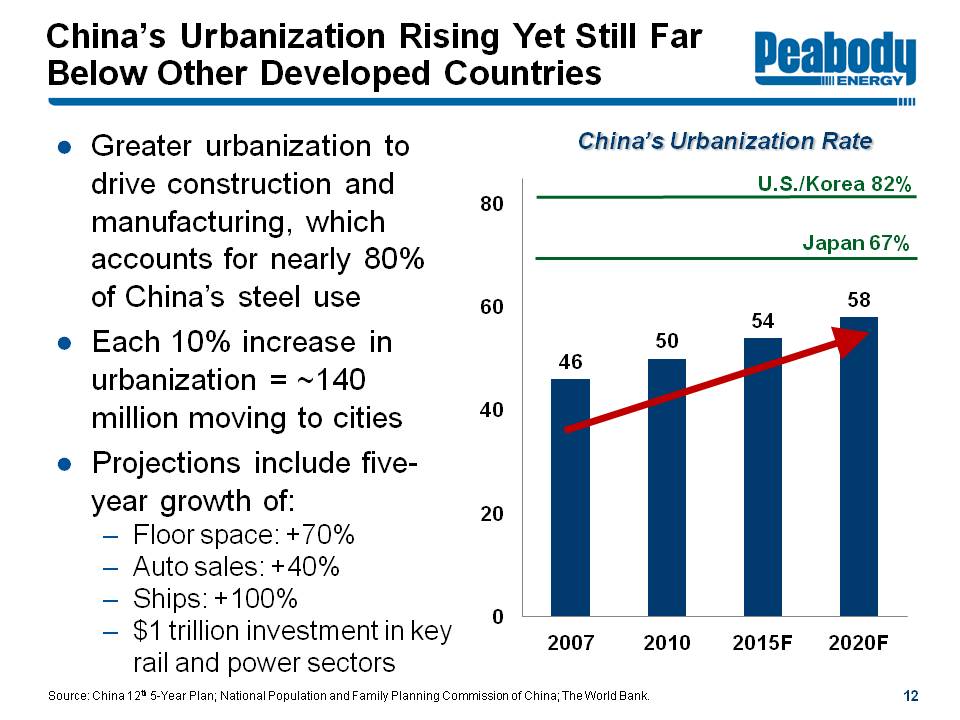
China's Urbanization Rising Yet Still Far Below Other Developed Countries
Greater urbanization to drive construction and manufacturing, which accounts for nearly 80% of China's steel use
Each 10% increase in urbanization = ~140 million moving to cities
Projections include five-year growth of:
Floor space: +70%
Auto sales: +40%
Ships: +100%
$1 trillion investment in key rail and power sectors
China's Urbanization Rate
U.S./Korea 82%
Japan 67%
2007 46
2010 50
2015F 54
2020F 58
Source: China 12th 5-Year Plan; National Population and Family Planning Commission of China; The World Bank.
12
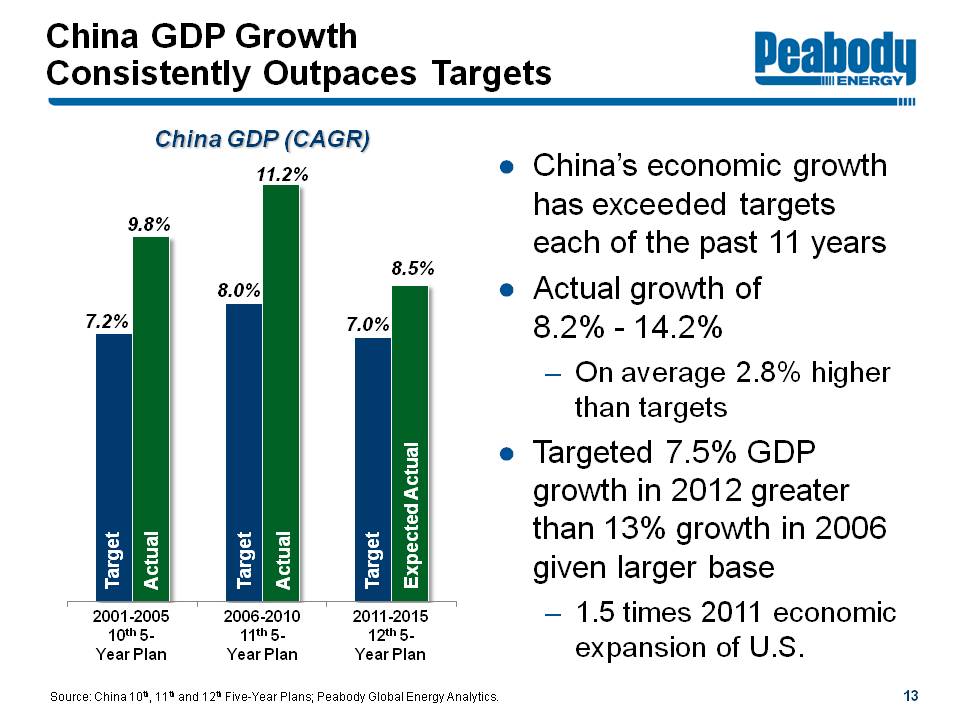
China GDP Growth Consistently Outpaces Targets
China GDP (CAGR)
2001-2005 10th 5-Year Plan Target 7.2% Actual 9.8%
2006-2010 11th 5-Year Plan Target 8.0% Actual 11.2%
2011-2015 12th 5-Year Plan Target 7.0% Expected Actual 8.5%
China's economic growth has exceeded targets each of the past 11 years
Actual growth of 8.2% - 14.2%
On average 2.8% higher than targets
Targeted 7.5% GDP growth in 2012 greater than 13% growth in 2006 given larger base
1.5 times 2011 economic expansion of U.S.
Source: China 10th, 11th and 12th Five-Year Plans; Peabody Global Energy Analytics.
13
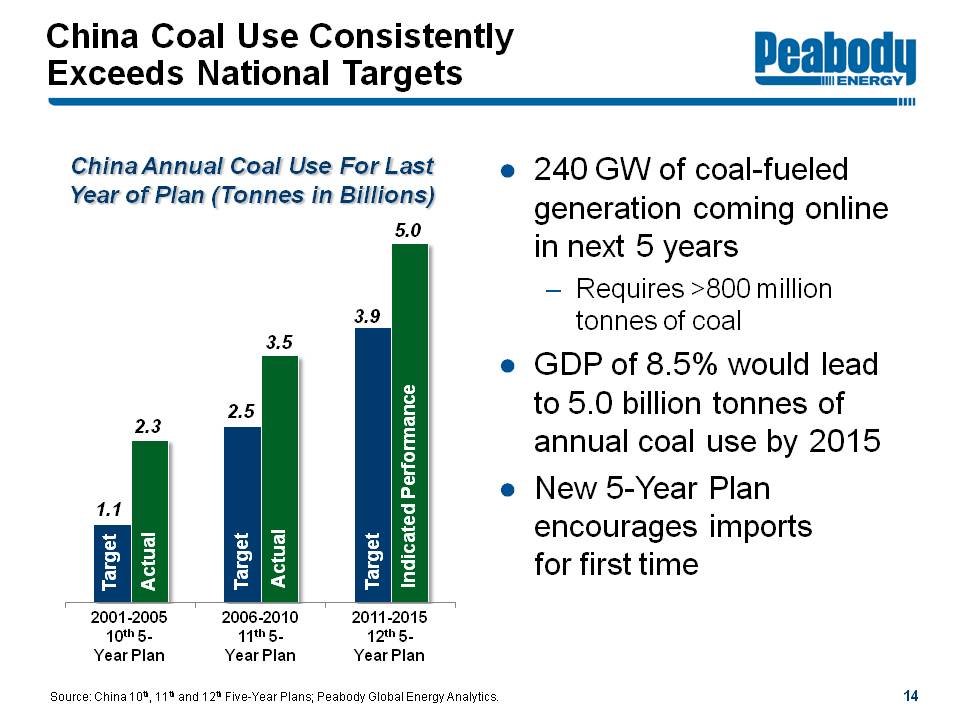
China Coal Use Consistently Exceeds National Targets
China Annual Coal Use For Last Year of Plan (Tonnes in Billions)
2001-2005 10th 5-Year Plan Target 1.1 Actual 2.3
2006-2010 11th 5-Year Plan Target 2.5 Actual 3.5
2011-2015 12th 5-Year Plan Target 3.9 Indicated Performance 5.0
240 GW of coal-fueled generation coming online in next 5 years
Requires >800 million tonnes of coal
GDP of 8.5% would lead to 5.0 billion tonnes of annual coal use by 2015
New 5-Year Plan encourages imports for first time
Source: China 10th, 11th and 12th Five-Year Plans; Peabody Global Energy Analytics.
14
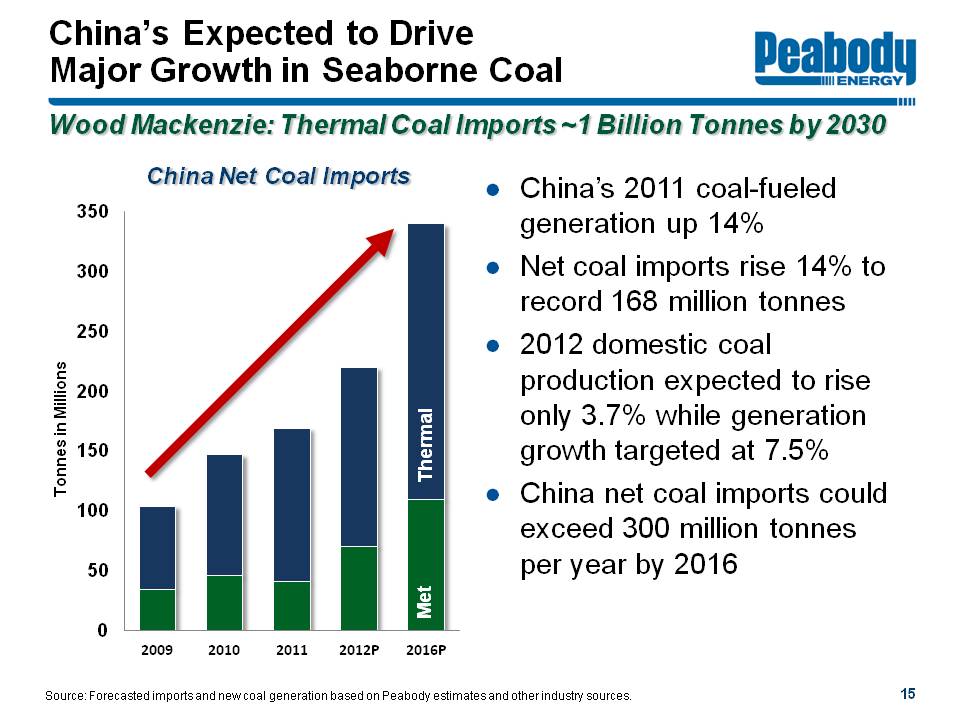
China's Expected to Drive Major Growth in Seaborne Coal
Wood Mackenzie: Thermal Coal Imports ~1 Billion Tonnes by 2030
China Net Coal Imports
Tonnes in Millions
2009 2010 2011 2012P 2016P Met Thermal
China's 2011 coal-fueled generation up 14%
Net coal imports rise 14% to record 168 million tonnes
2012 domestic coal production expected to rise only 3.7% while generation growth targeted at 7.5%
China net coal imports could exceed 300 million tonnes per year by 2016
Source: Forecasted imports and new coal generation based on Peabody estimates and other industry sources.
15
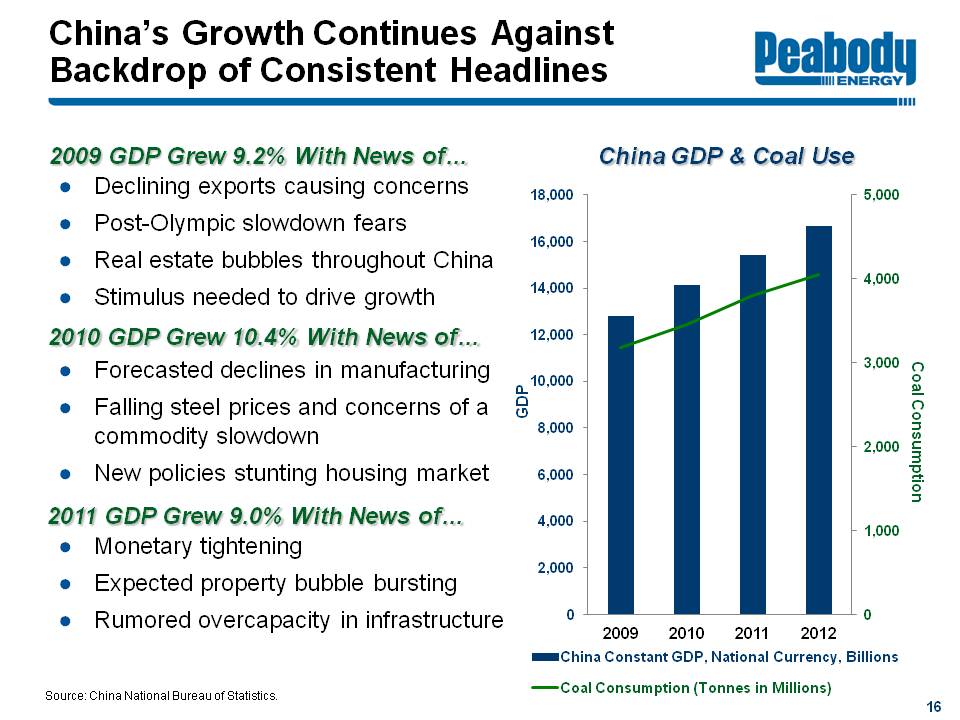
China's Growth Continues Against Backdrop of Consistent Headlines
2009 GDP Grew 9.2% With News of…
Declining exports causing concerns
Post-Olympic slowdown fears
Real estate bubbles throughout China
Stimulus needed to drive growth
2010 GDP Grew 10.4% With News of…
Forecasted declines in manufacturing
Falling steel prices and concerns of a commodity slowdown
New policies stunting housing market
2011 GDP Grew 9.0% With News of…
Monetary tightening
Expected property bubble bursting
Rumored overcapacity in infrastructure
China GDP & Coal Use
GDP
2009 2010 2011 2012
Coal Consumption
China Constant GDP, National Currency, Billions
Coal Consumption (Tonnes in Millions)
Source: China National Bureau of Statistics.
16
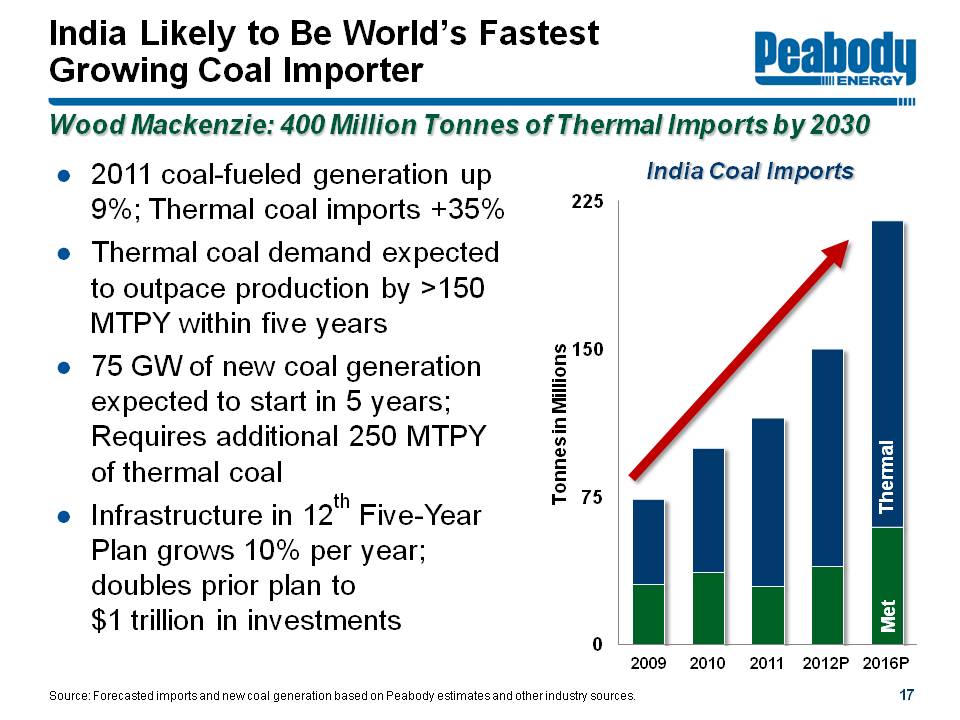
India Likely to Be World's Fastest Growing Coal Importer
Wood Mackenzie: 400 Million Tonnes of Thermal Imports by 2030
2011 Coal-Fueled Generation up 9%; Thermal Coal Imports +35%
Thermal coal demand expected to outpace production by >150 MTPY within five years
75 GW of new coal generation expected to start in 5 years; Requires additional 250 MTPY of thermal coal
Infrastructure in 12th Five-Year Plan grows 10% per year; doubles prior plan to $1 trillion in investments
India Coal Imports
Tonnes in Millions
2009 2010 2011 2012P 2016P Met Thermal
Source: Forecasted imports and new coal generation based on Peabody estimates and other industry sources.
17
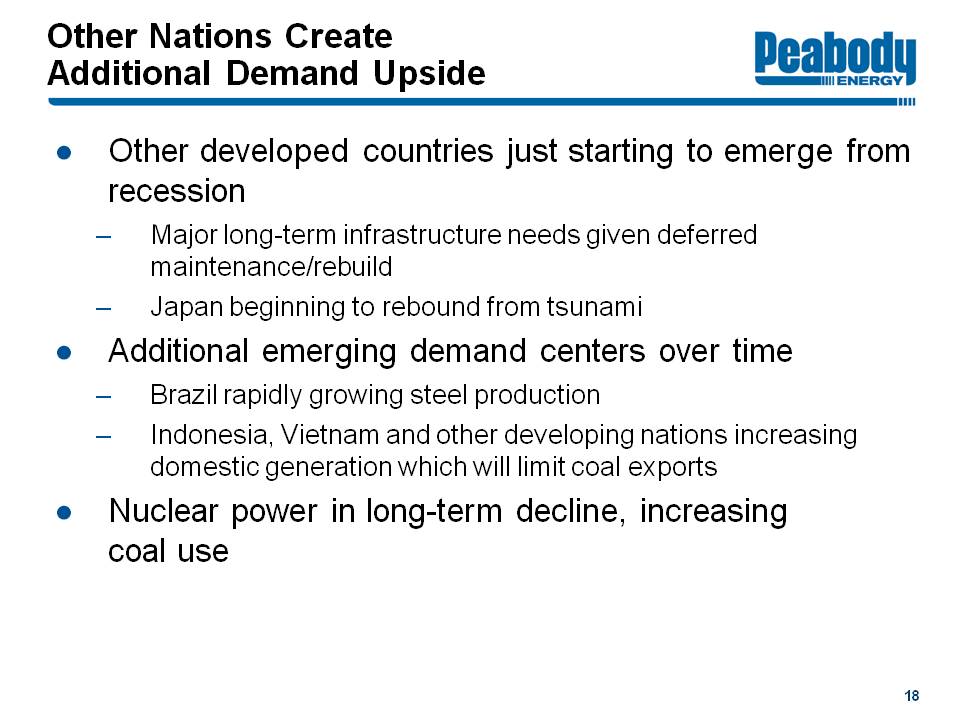
Other Nations Create Additional Demand Upside
Other developed countries just starting to emerge from recession
Major long-term infrastructure needs given deferred maintenance/rebuild
Japan beginning to rebound from tsunami
Additional emerging demand centers over time
Brazil rapidly growing steel production
Indonesia, Vietnam and other developing nations increasing domestic generation which will limit coal exports
Nuclear power in long-term decline, increasing coal use
18
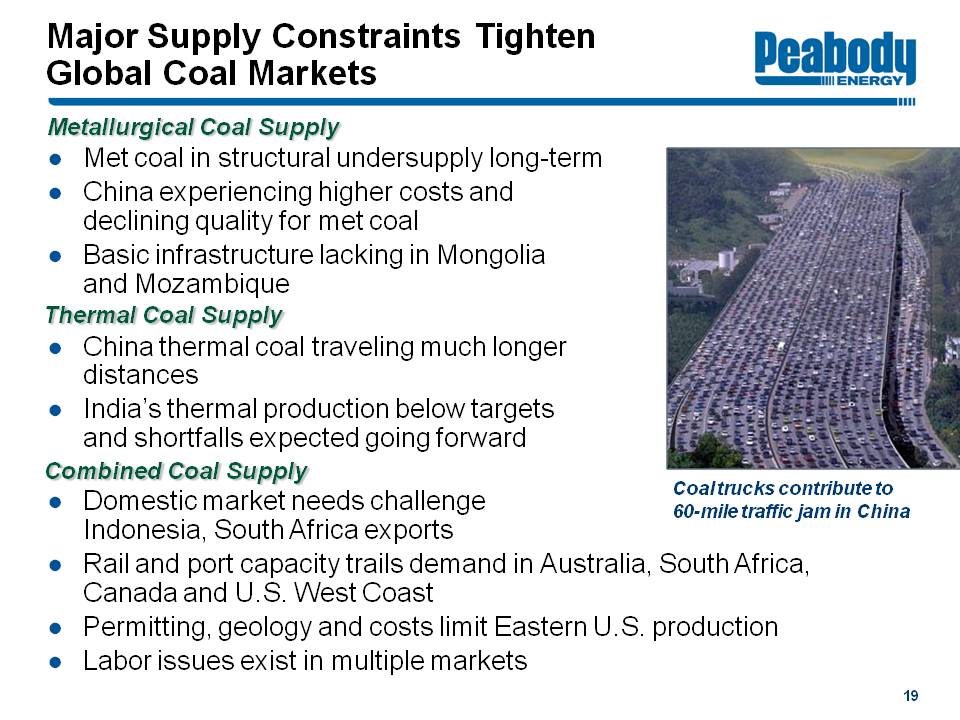
Major Supply Constraints Tighten Global Coal Markets
Metallurgical Coal Supply
Met coal in structural undersupply long-term
China experiencing higher costs and declining quality for met coal
Basic infrastructure lacking in Mongolia and Mozambique
Thermal Coal Supply
China thermal coal traveling much longer distances
India's thermal production below targets and shortfalls expected going forward
Combined Coal Supply
Domestic market needs challenge Indonesia, South Africa exports
Rail and port capacity trails demand in Australia, South Africa, Canada and U.S. West Coast
Permitting, geology and costs limit Eastern U.S. production
Labor issues exist in multiple markets
Coal trucks contribute to 60-mile traffic jam in China
19
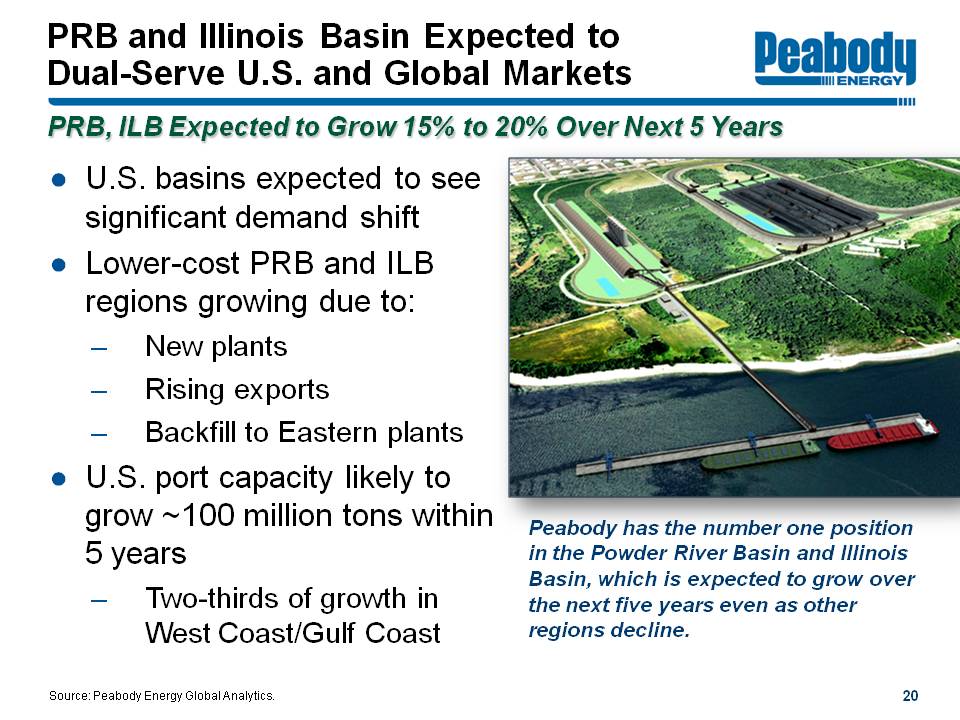
PRB and Illinois Basin Expected to Dual-Serve U.S. and Global Markets
PRB and Illinois Basin Expected to Grow 15% to 20% Over Next 5 Years
U.S. basins expected to see significant demand shift
Lower-cost PRB and ILB regions growing due to:
New plants
Rising exports
Backfill to Eastern plants
U.S. port capacity likely to grow ~100 million tons within 5 years
Two-thirds of growth in West Coast/Gulf Coast
Peabody has the number one position in the Powder River Basin and Illinois Basin, which is expected to grow over the next five years even as other regions decline.
Source: Peabody Energy Global Analytics.
20
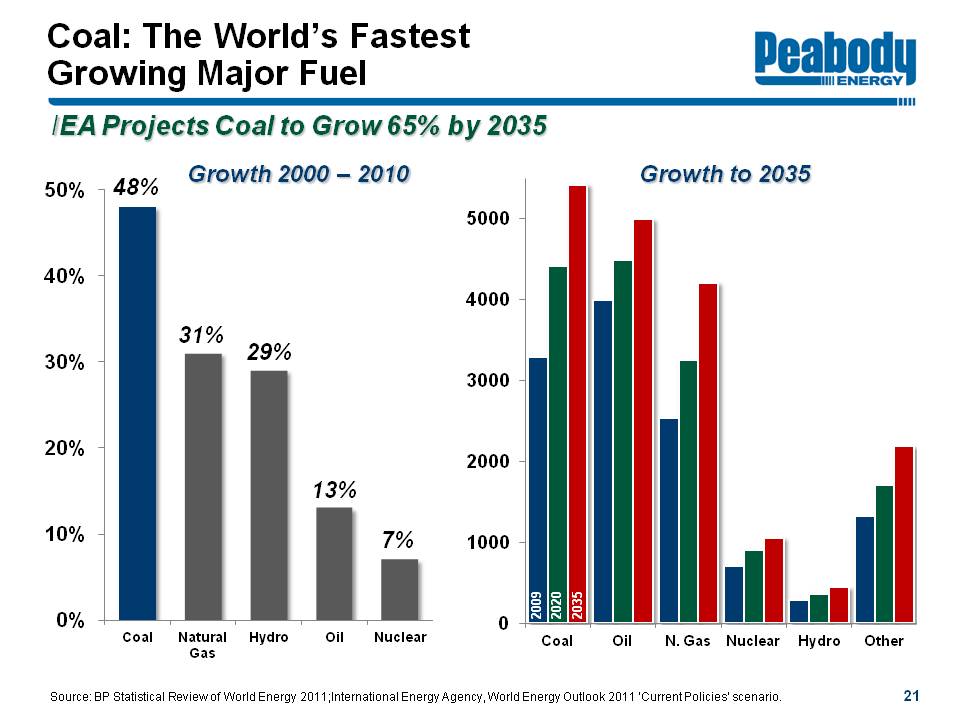
Coal: The World's Fastest Growing Major Fuel
IEA Projects Coal to Grow 65% by 2035
Growth 2000-2010
Coal 48% Natural Gas 31% Hydro 29% Oil 13% Nuclear 7%
Growth to 2035
2009 2020 2035
Coal N. Gas Nuclear Hydro Other
Source: BP Statistical Review of World Energy 2011; International Energy Agency, World Energy Outlook 2011 'Current Policies' scenario.
21
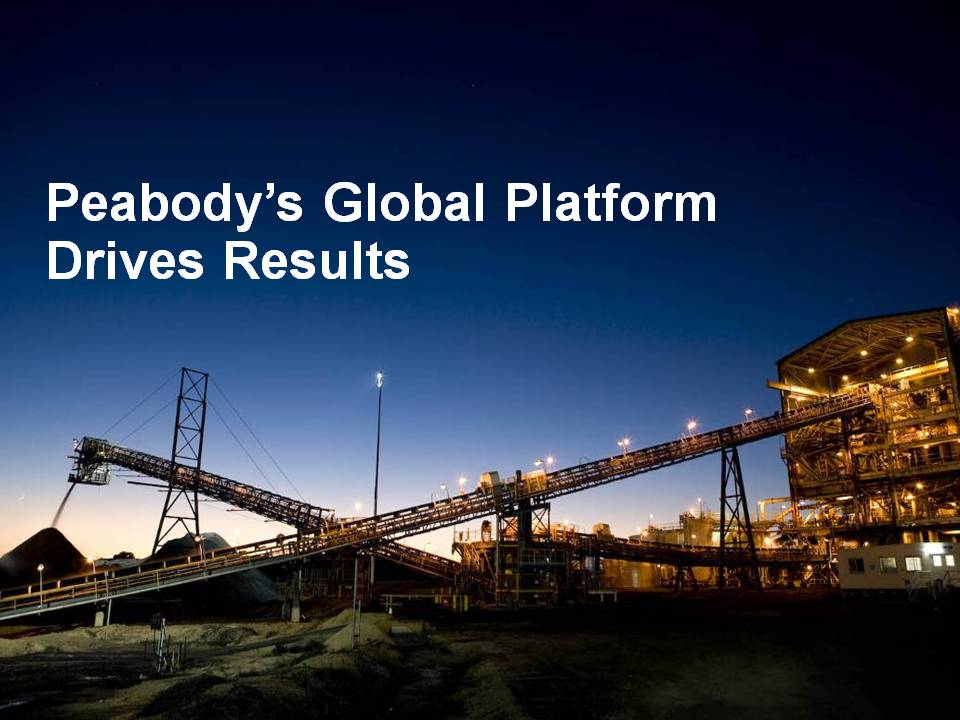
Peabody's Global Platform Drives Results
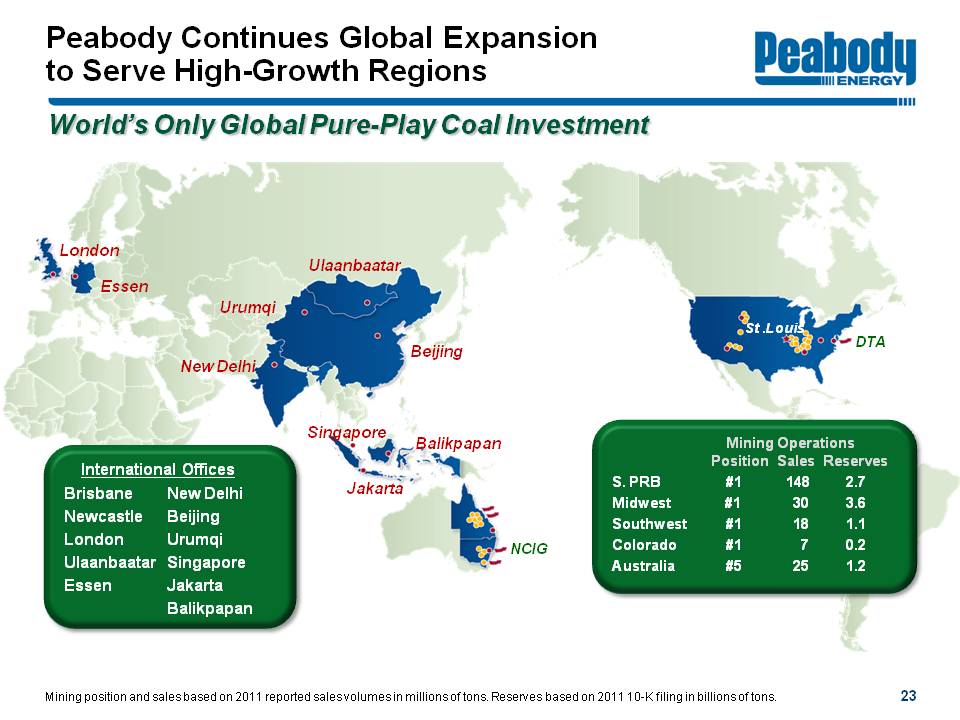
Peabody Continues Global Expansion to Serve High-Growth Regions
World's Only Global Pure-Play Coal Investment
International Offices
Brisbane New Delhi Newcastle Beijing London Urumqi Ulaanbaatar Singapore Essen Jakarta Balikpapan
London Essen New Delhi Urumqi Ulaanbaatar Beijing Singapore Jakarta Balikpapan NCIG St. Louis DTA
Mining Operations
Position S. PRB #1 Midwest #1 Southwest #1 Colorado #1 Australia #5
Sales S. PRB 148 Midwest 30 Southwest 18 Colorado 7 Australia 25
Reserves S. PRB 2.7 Midwest 3.6 Southwest 1.1 Colorado 0.2 Australia 1.2
Mining position and sales based on 2011 reported sales volumes in millions of tons. Reserves based on 2011 10-K filing in billions of tons.
23

Peabody Delivers Strong Margins Superior to Coal Peer Average
Contributions to Gross Margins Lead Peers
Gross Margins
2010 25% 28% 41% 2011 NYSE Peer Avg. 25% Peabody U.S. 27% Peabody Australia 41%
Peabody's U.S. and Australia margins surpass NYSE coal peers
Leading producer in low-cost regions in the U.S. with high-margin operations in Australia
Source: Publicly filed documents. Peers include ACI, ANR, CNX, PCX, CLD, WLT, MEE and ICO.
24
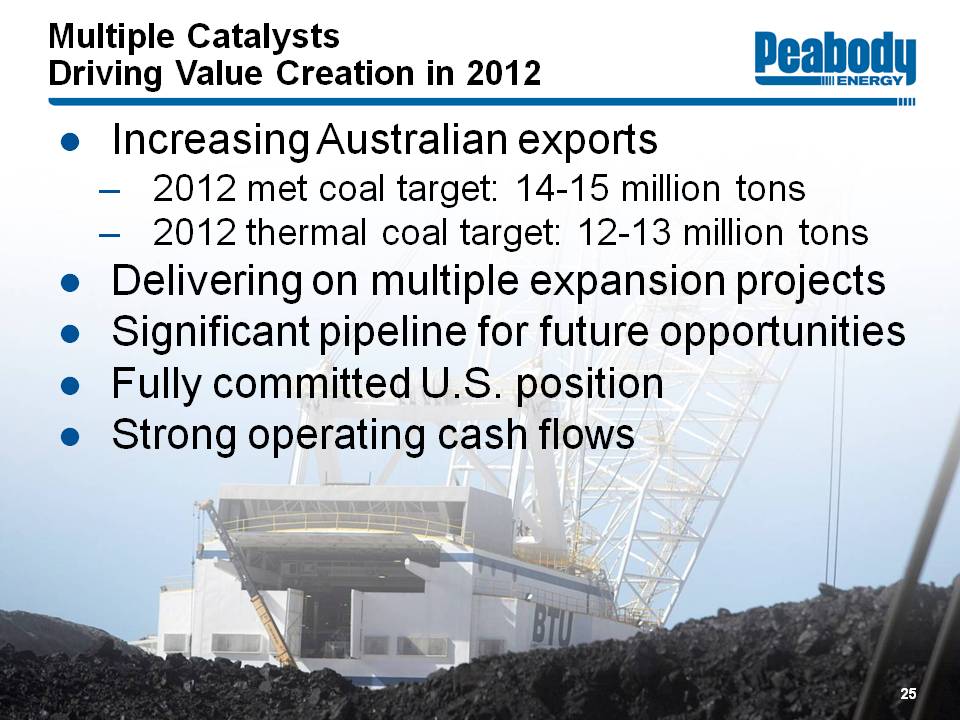
Multiple Catalysts Driving Value Creation in 2012
Increasing Australian exports
2012 met coal target: 14-15 million tons
2012 thermal coal target: 12-13 million tons
Delivering on multiple expansion projects
Significant pipeline for future opportunities
Fully committed U.S. position
Strong operating cash flows
25
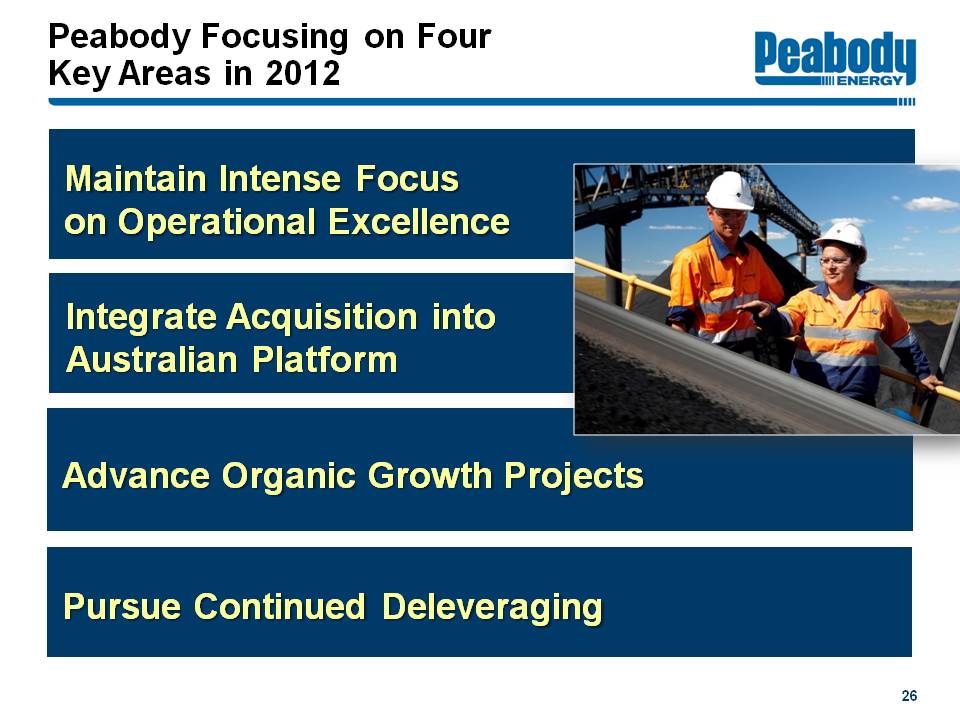
Peabody Focusing on Four Key Areas in 2012
Maintain Intense Focus on Operational Excellence
Integrate Acquisition into Australian Platform
Advance Organic Growth Projects
Pursue Continued Deleveraging
26
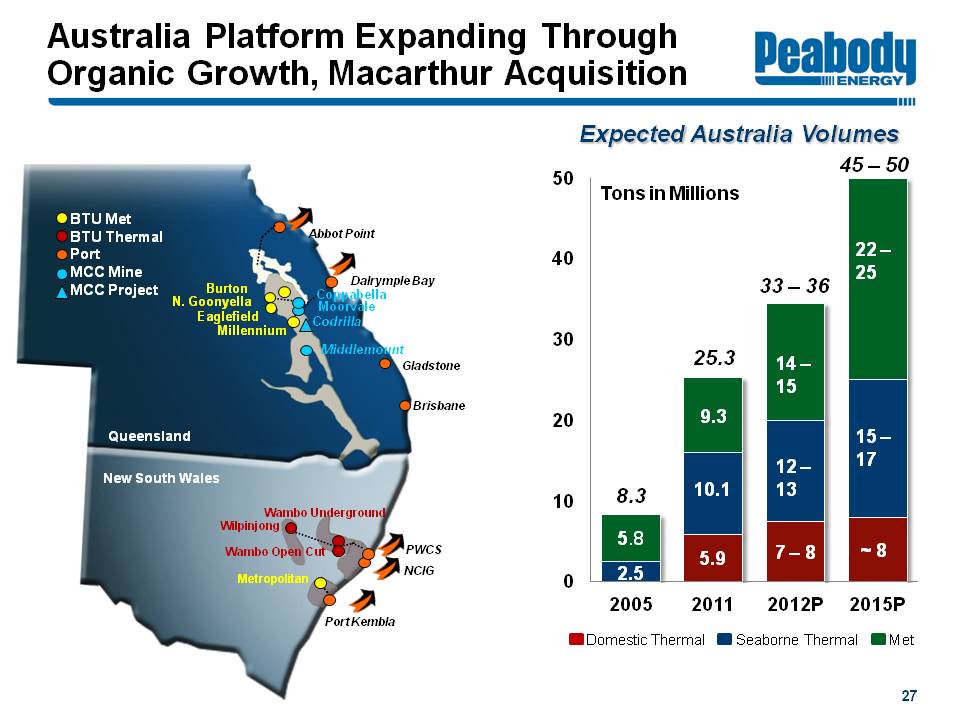
Australia Platform Expanding Through Organic Growth, Macarthur Acquisition
Queensland
Port Abbot Point Dalrymple Bay Gladstone Brisbane
BTU Met Burton N. Goonyella Eaglefield Millennium
MCC Mine Coppabella Moorvale Middlemount
MCC Project Codrilla
New South Wales
Port PWCS NCIG Port Kembla
BTU Thermal Wilpinjong Wambo Underground Wambo Open Cut
BTU Met Metropolitan
Expected Australia Volumes
Tons in Millions
2005 Seaborne Thermal 2.5 Met 5.8 Total 8.3
2011 Domestic Thermal 5.9 Seaborne Thermal 10.1 Met 9.3 Total 25.3
2012P Domestic Thermal 7-8 Seaborne Thermal 12-13 Met 14-15 Total 33-36
2015P Domestic Thermal ~8 Seaborne Thermal 15-17 Met 22-25 Total 45-50
27
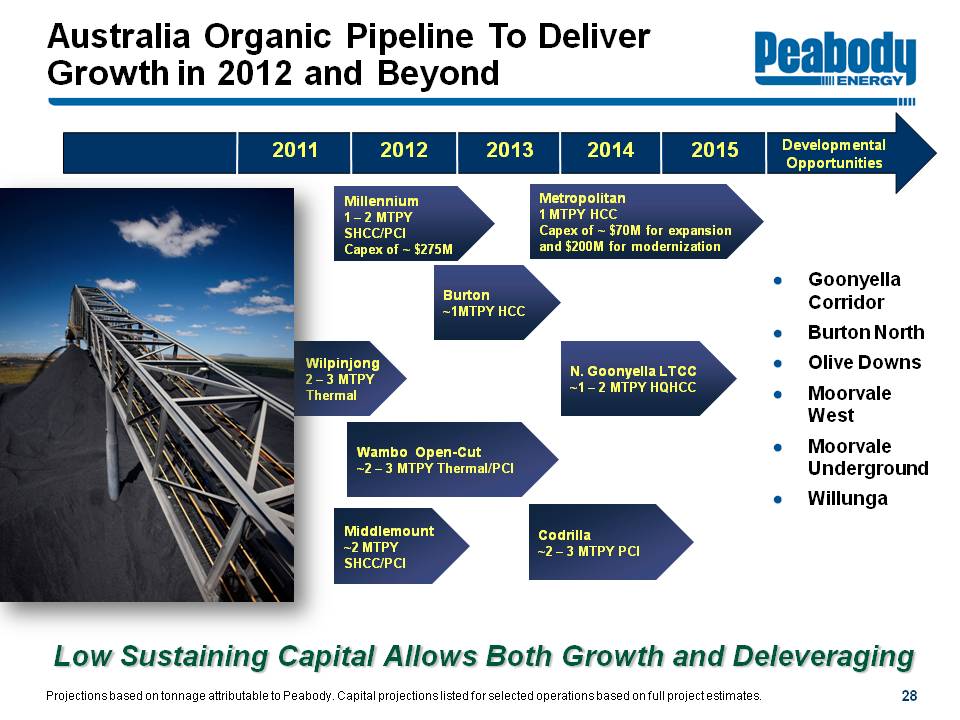
Australia Organic Pipeline To Deliver Growth in 2012 and Beyond
2011 2012 2013 2014 2015
Wilpinjong 2 - 3 MTPY Thermal
Millennium 1 - 2 MTPY SHCC/PCI Capex of ~ $275M
Wambo Open-Cut 2 - 3 MTPY Thermal/PCI
Middlemount ~2 MTPY SHCC/PCI
Burton ~1MTPY HCC
Metropolitan 1 MTPY HCC Capex of ~ $70M for expansion and $200M for modernization
N. Goonyella LTCC 1 - 2 MTPY HQHCC
Codrilla ~2 - 3 MTPY PCI
Developmental Opportunities Goonyella Corridor Burton North Olive Downs Moorevale West Moorevale Underground Willunga
Low Sustaining Capital Allows Both Growth and Deleveraging
Projections based on tonnage attributable to Peabody. Capital projections listed for selected operations based on full project estimates.
28
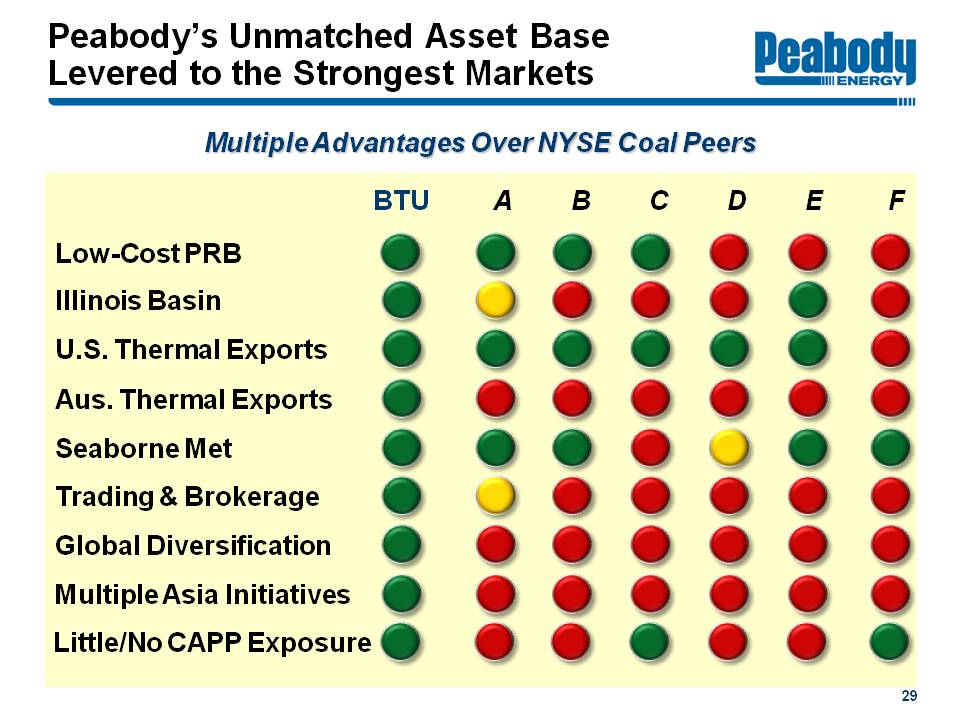
Peabody's Unmatched Asset Base Levered to the Strongest Markets
Multiple Advantages Over NYSE Coal Peers
BTU A B C D E F
Low-Cost PRB
Illinois Basin
U.S. Thermal Exports
Aus. Thermal Exports
Seaborne Met
Trading & Brokerage
Global Diversification
Multiple Asia Initiatives
Little/No CAPP Exposure
29
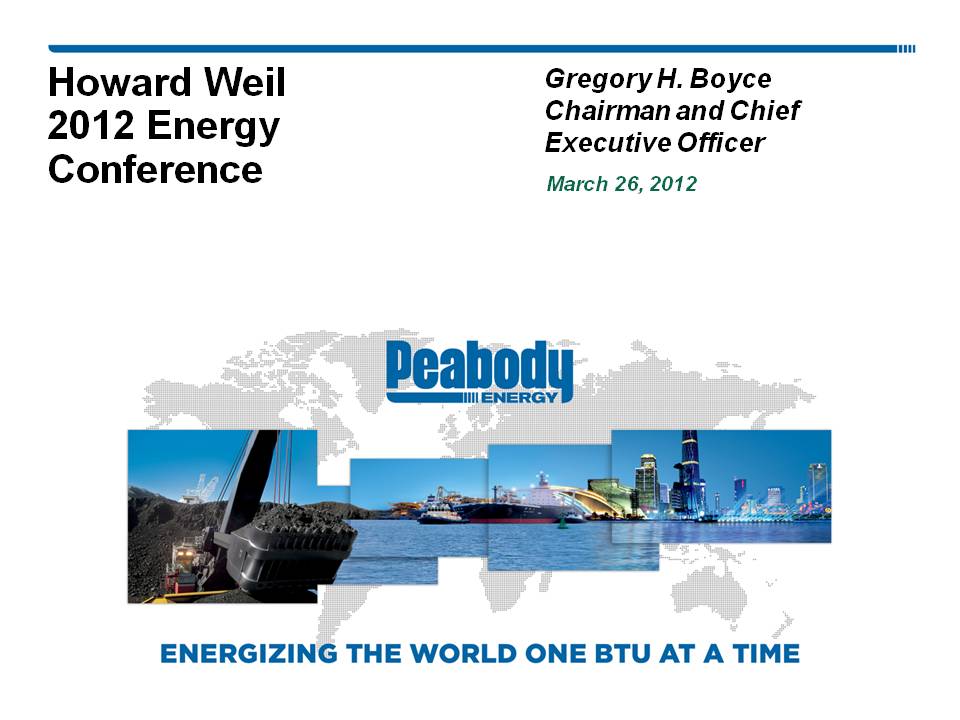
Howard Weil 2012 Energy Conference
Gregory H. Boyce Chairman and Chief Executive Officer
March 26, 2012
Peabody Energy
Energizing The World One BTU At A Time

Appendix:
Reconciliation of Adjusted EBITDA
Reconciliation of Adjusted EBITDA to Income from Continuing Operations, Net of Income Taxes (unaudited)
Year Ended December 31, 2011 2010 2009 2008 2007
Adjusted EBITDA $2,128.7 $1,838.7 $1,262.8 $1,728.2 $958.2
Depreciation, depletion and amortization 482.2 437.1 400.5 397.8 342.9
Asset retirement obligation expense 53.1 47.2 39.9 48.1 23.7
Interest expense, net 219.7 212.4 193.0 217.1 228.8
Income tax provision (benefit) 363.2 315.4 186.2 159.8 (73.1)
Income from continuing operations, net of income taxes $1,010.5 $826.6 $443.2 $905.4 $435.9
EBITDA (also called Adjusted EBITDA) is defined as income from continuing operations before deducting net interest expense, income taxes, asset retirement obligation expense and depreciation, depletion and amortization. EBITDA, which is not calculated identically by all companies, is not a substitute for operating income, net income or cash flow as determined in accordance with United States generally accepted accounting principles. Management uses EBITDA as a key measure of operating performance and also believes it is a useful indicator of the company's ability to meet debt service and capital expenditure requirements.
31
